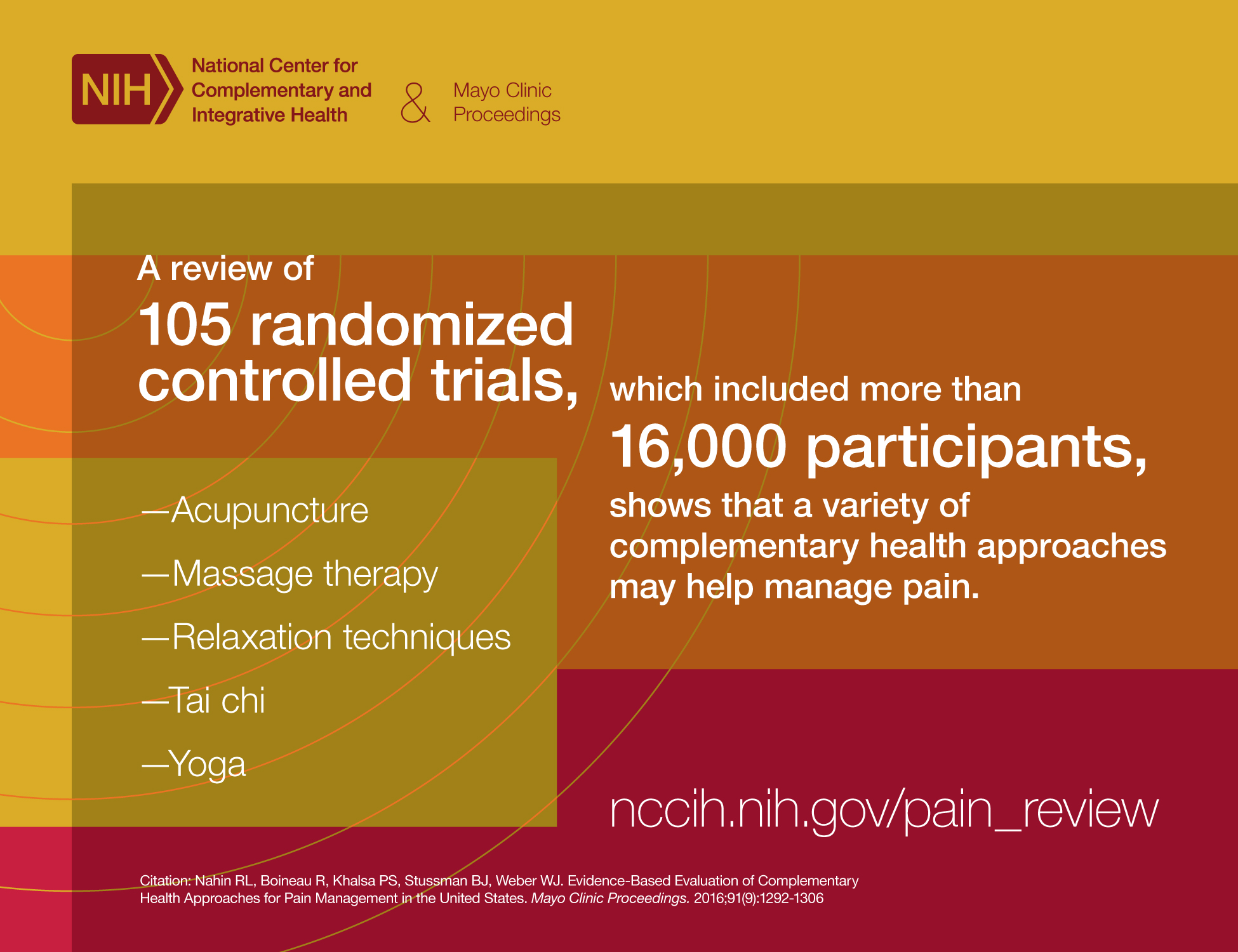NIH Review Finds Nondrug Approaches Effective For Treatment of Common Pain Conditions
U.S. study reviews trial results on complementary health approaches for pain relief; aims to assist with pain management
For Immediate Release:
Thursday, September 1, 2016

Data from a review of U.S.-based clinical trials published today in Mayo Clinic Proceedings suggest that some of the most popular complementary health approaches—such as yoga, tai chi, and acupuncture—appear to be effective tools for helping to manage common pain conditions. The review was conducted by a group of scientists from the National Center for Complementary and Integrative Health (NCCIH) at the National Institutes of Health.
Millions of Americans suffer from persistent pain that may not be fully relieved by medications. They often turn to complementary health approaches to help, yet primary care providers have lacked a robust evidence base to guide recommendations on complementary approaches as practiced and available in the United States. The new review gives primary care providers—who frequently see patients with chronic pain—tools to inform decisionmaking on how to help manage that pain.
“For many Americans who suffer from chronic pain, medications may not completely relieve pain and can produce unwanted side effects. As a result, many people may turn to nondrug approaches to help manage their pain,” said Richard L. Nahin, Ph.D., NCCIH’s lead epidemiologist and lead author of the analysis. “Our goal for this study was to provide relevant, high-quality information for primary care providers and for patients who suffer from chronic pain.”
The researchers reviewed 105 U.S.-based randomized controlled trials, from the past 50 years, that were relevant to pain patients in the United States and met inclusion criteria. Although the reporting of safety information was low overall, none of the clinical trials reported significant side effects due to the interventions.
The review focused on U.S.-based trial results on seven approaches used for one or more of five painful conditions—back pain, osteoarthritis, neck pain, fibromyalgia, and severe headaches and migraine—and found promise in the following for safety and effectiveness in treating pain:
- Acupuncture and yoga for back pain
- Acupuncture and tai chi for osteoarthritis of the knee
- Massage therapy for neck pain with adequate doses and for short-term benefit
- Relaxation techniques for severe headaches and migraine.
Though the evidence was weaker, the researchers also found that massage therapy, spinal manipulation, and osteopathic manipulation may provide some help for back pain, and relaxation approaches and tai chi might help people with fibromyalgia.
“These data can equip providers and patients with the information they need to have informed conversations regarding nondrug approaches for treatment of specific pain conditions,” said David Shurtleff, Ph.D., deputy director of NCCIH. “It’s important that continued research explore how these approaches actually work and whether these findings apply broadly in diverse clinical settings and patient populations.”
Read more about this report at nccih.nih.gov/pain_review.
References
- Nahin RL, Boineau R, Khalsa PS, Stussman BJ, Weber WJ. Evidence-based evaluation of complementary health approaches for pain management in the United States. Mayo Clinic Proceedings. 2016;91(9):1292–1306.
###
About the National Center for Complementary and Integrative Health (NCCIH):
NCCIH’s mission is to define, through rigorous scientific investigation, the usefulness and safety of complementary and integrative health approaches and their roles in improving health and health care. For additional information, call NCCIH’s Clearinghouse toll free at 1-888-644-6226. Follow us on X, Facebook , and YouTube.
About the National Institutes of Health (NIH): NIH, the nation’s medical research agency, includes 27 Institutes and Centers and is a component of the U.S. Department of Health and Human Services. NIH is the primary federal agency conducting and supporting basic, clinical, and translational medical research, and is investigating the causes, treatments, and cures for both common and rare diseases. For more information about NIH and its programs, visit www.nih.gov.